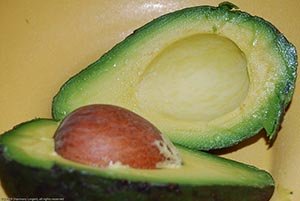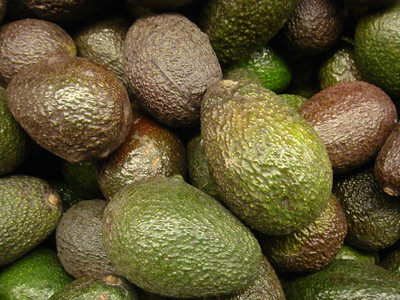Avocados Nutrition facts
Avocados are uniquely buttery yet subtly flavored pear-shaped fruits originating from Central America. Distinguished by their high fat content and calorie density compared to most other fruits, they remain popular for their nutritious profile and health-promoting qualities.
Botanically, avocados belong to the Lauraceae family, which includes notable members such as bay laurel and cinnamon. Their scientific name is Persea americana.
Commonly referred to as alligator pear, aguacate, butter pear, and other names.
 |
| Avocado (Persea americana). Notice creamy flesh and brown pit inside. Photo courtesy: HormonyRae |
The avocado tree is a medium-sized evergreen, typically growing to heights of 20-30 feet, adorned with expansive green foliage. Thriving in fertile soil with ample moisture, it produces small, light-green flowers during the winter season. Within 8-10 months post-bloom, the tree bears an abundance of pear-shaped green fruits.
 |
| Mature and ripen Hass-variety avocados in the market. Notice deep-brown fruits with pebble surface. Photo courtesy: ollesvensson |
Avocados reach maturity while still on the tree, but they only ripen after being harvested. When ripe, the fruit yields to gentle thumb pressure and its skin transitions from light green to a deeper green or purple hue.
Internally, the avocado's creamy flesh boasts a buttery texture, accompanied by a subtle yet pleasant fruity fragrance. At its core lies a hard, brown seed.
Typically, each fruit weighs between 300-700 grams, although it's not uncommon to find larger avocados in markets.
Health Benefits of Avocado
Similar to olives, avocados are abundant in monounsaturated fats and calories. Nevertheless, they offer rich reserves of dietary fiber, vitamins, minerals, and a plethora of health-supporting plant compounds.
The creamy flesh of avocados is a notable source of monounsaturated fatty acids such as oleic and palmitoleic acids, along with the omega-6 polyunsaturated fatty acid, linoleic acid.
Studies indicate that diets like the Mediterranean diet, which are high in monounsaturated fatty acids, aid in reducing LDL or "bad" cholesterol and increasing HDL or "good" cholesterol, thereby reducing the risk of coronary artery disease and stroke by promoting a favorable blood lipid profile.
Avocados are rich in both soluble and insoluble dietary fiber. With 6.7 grams per 100 grams of fruit, they contribute approximately 18% of the recommended daily fiber intake. Dietary fiber plays a role in lowering blood cholesterol levels and preventing constipation.
Furthermore, avocados contain significant levels of tannins, akin to persimmons. Tannin, once considered an antinutritional agent, possesses beneficial anti-inflammatory, anti-ulcer, and antioxidant properties.
The creamy flesh of avocados contains various health-promoting flavonoid polyphenolic antioxidants, including cryptoxanthin, lutein, zeaxanthin, beta-carotene, and alpha-carotene. These compounds act as protective scavengers against oxygen-derived free radicals and reactive oxygen species, which contribute to aging and various diseases.
The total antioxidant strength (ORAC) of avocados (Hass variety, raw) is measured at 1933 µmol TE/100 grams.
Avocados are also rich in several health-supporting vitamins, primarily concentrated in their creamy pulp, including vitamins A, E, and K.
Furthermore, avocados are excellent sources of minerals such as iron, copper, magnesium, and manganese. Magnesium is crucial for bone health and has a protective role in heart health. Manganese acts as a cofactor for the antioxidant enzyme superoxide dismutase. Iron and copper are essential for red blood cell production.
Fresh avocado is notably high in potassium, providing 485 milligrams per 100 grams, approximately 10% of the recommended daily intake. Potassium plays a vital role in regulating heart rate and blood pressure, counteracting the adverse effects of sodium.
| Principle | Nutrient Value | Percent of RDA |
|---|---|---|
| Energy | 160 Kcal | 8% |
| Carbohydrates | 8.53 g | 6.5% |
| Protein | 2.0 g | 3.5% |
| Total Fat | 14.66 g | 48% |
| Cholesterol | 0 mg | 0% |
| Dietary Fiber | 6.7 g | 18% |
| Vitamins | ||
| Folates | 81 µg | 20% |
| Niacin | 1.738 mg | 11% |
| Pantothenic acid | 1.389 mg | 28% |
| Pyridoxine | 0.257 mg | 20% |
| Riboflavin | 0.130 mg | 10% |
| Thiamin | 0.067 mg | 5.5% |
| Vitamin-A | 146 IU | 5% |
| Vitamin-C | 10 mg | 17% |
| Vitamin-E | 2.07 mg | 14% |
| Vitamin-K | 21 µg | 17.5% |
| Electrolytes | ||
| Sodium | 7 mg | 0.5% |
| Potassium | 485 mg | 10% |
| Minerals | ||
| Calcium | 12 mg | 1% |
| Copper | 0.190 mg | 21% |
| Iron | 0.55 mg | 7% |
| Magnesium | 29 mg | 7% |
| Manganese | 0.142 mg | 6% |
| Phosphorus | 52 mg | 7% |
| Selenium | 0.4 µg | <1% |
| Zinc | 0.64 mg | 6% |
| Phyto-nutrients | ||
| Carotene-&alpha | 24 µg | -- |
| Carotene-ß | 62 µg | -- |
| Cryptoxanthin-ß | 28 µg | -- |
| Lutein-zeaxanthin | 271 µg | -- |
Selection and storage
Avocados are readily available year-round in the market. When selecting, opt for medium-sized fruits that are fully ripe and emit a pleasant aroma. To assess ripeness, gently press the fruit.
Avoid overly hard avocados, as they may require additional time to ripen. Conversely, steer clear of overly soft, ripe fruits, as they may be mushy and lacking in flavor. Inspect the surface for any cuts, blemishes, or bruising, and avoid purchasing such avocados.
Once at home, store avocados in a fruit basket in a cool, dark location. If they are unripe, consider wrapping them in paper alongside a ripe banana or apple to expedite the ripening process.
Preparation and Serving methods
Avocado possesses a delicate nutty flavor, smooth buttery texture, and mild taste. To enjoy, slice the fruit lengthwise through the center, circling around the seed. Twist the halves in opposite directions and gently separate them. Remove the seed with a spoon. Peel the skin starting from the stem end using your fingers. Cut the flesh into desired cubes with a knife.
To prevent enzymatic browning, sprinkle or rinse the cut sections of the fruit with lemon juice.
 |
| Photo courtesy: The essential vegetarian cookbook from Thunder bay press. |
In various regions of Central America, avocados are often enjoyed simply with a sprinkle of black pepper, a splash of lime juice, and a dash of salt.
Avocado sections or cubes can enhance the flavor of vegetable and fruit salads, salsa, and other dishes.
Mashed avocado is a key ingredient in traditional Mexican dishes such as polenta and pancakes. Guacamole, a beloved Mexican dip, is primarily avocado-based.
Similarly, guasacaca is a Venezuelan variation of guacamole salsa made with vinegar instead of lemon juice.
Avocado puree can be incorporated into ice cream, milkshakes, and fruit juices for a creamy and nutritious addition.
Safety Profile
When raw and unripe, avocados contain high levels of tannins, imparting a bitter and unpalatable taste. Additionally, excessive tannin consumption can hinder the absorption of vitamins and minerals in the digestive system.
Although uncommon, consuming avocados may trigger allergic reactions in individuals sensitive to latex. Symptoms may include throat itching, hives, runny nose, and shortness of breath. These reactions are typically mild and resolve on their own. (Medical disclaimer).
≻≻- Back to Fruits from Avocados. Visit here for an impressive list of all varieties of fruits with complete illustrations of their nutrition facts and health benefits.
≻≻- Back to Home page.
Further resources:
Persea americana- Purdue horticulture university.